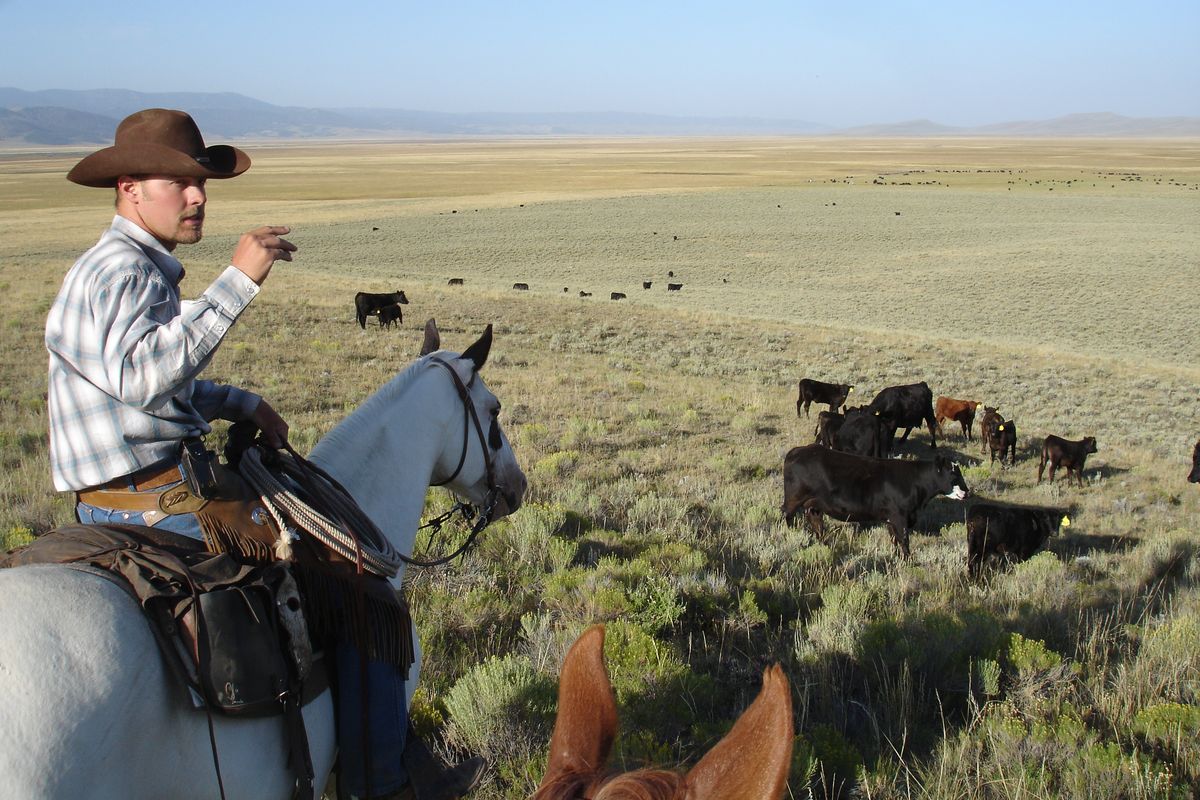Home on the Range: Montana ranch-raised beef

It’s 6 a.m. on a cloudless big sky summer morning. J Bar L wranglers have 10 saddle horses for guests and cowboys to move 750 head of cattle from the Red Rock Lakes National Wildlife Refuge in one of the most remote valleys of Montana. The bovine are not trespassers. Ranch manager Bryan Ulring explains that the ranch leases grazing rights on the refuge, an effort to both maintain traditional land use and to manage the grasslands—and raise healthful meat using sustainable practices.
“Our grass management, range management plan includes pasture rotation and is planned with the refuge’s trumpeter swans and their nesting in mind,” says Ulring from saddle vantage point atop a sorrel mare. Trumpeter swans were once considered extinct, but in the Centennial Valley a small flock remained hidden from the world. Seventy-five years ago, the federal refuge system began conservation to restore the swans.
With instructions from the cowboys, the paying guests help move the bovine herd from a 1,000-acre pasture on the refuge, down the dusty north-side of the road that circumnavigates the refuge, and into another pasture, where the Angus will stay for a few days before being pushed to another pasture. The sweeping view across the valley and the refuge to the south includes the tallest peak in the Centennial Range, Mt. Jefferson at 10,203 feet.
The cattle are nonplused about the views from the 6,600 feet elevation prairie. It’s the native grasses, Timothy and fescues in the marsh-prairie-montane environment that draw bovine attention—and more often, attract attention of grocery store and restaurant patrons too because of the health benefits of range-raised livestock verses feedlot animals.
According to investigative journalist and New York Times best-selling author Jo Robinson, “Since the late 1990s, a growing number of ranchers have stopped sending their animals to the feedlots to be fattened on grain, soy and other supplements. Instead, they are keeping their animals home on the range where they forage on pasture, their native diet.”
While researching the book, The Omega Diet, co-authored with Dr. Artemis Simopoulos, Robinson learned that meat from pasture-raised animals is very similar to meat from wild game and that both promote optimal health.
“A major benefit of raising animals on pasture is that their products are healthier for you,” writes Robinson from her Vashon Island, Wash. home. “For example, compared with feedlot meat, meat from grass-fed beef, bison, lamb and goats has less total fat, saturated fat, cholesterol and calories. It also has more vitamin E, beta-carotene, vitamin C and a number of health-promoting fats, including omega-3 fatty acids.”
Ulring agrees. “Our cattle are raised on thousands of acres of pristine Montana pasture land without the use of hormones, antibiotics or feedlots. Because they are grass-fed and finished, their meat is high in healthy Omega-3 fatty acids and low in potentially harmful Omega-6’s, which are elevated in corn-fed beef.”
The 11,000-foot Madison Range to the north of the J Bar L Ranch scrapes the big sky. Between the 50,000-acre refuge and the peaks, a few large ranches abut the refuge’s boundary. Some of those ranches purchase grazing on the part of the refuge’s 22,995 acres of grassland. One such cattle operation is the J Bar L Ranch, owned by Peggy Rockefeller Dulany and operated as a guest facility and working cattle ranch. It’s a 45-minute gravel-road drive from Exit 0, Interstate I-5 at Monida, Mont. to the J Bar L, situated on the north side of Lower Red Rock Lake.
The J Bar L hosts just a dozen guests a week, some of the 12,000 visitors that visit Red Rocks Lakes National Wildlife Refuge annually—a petite number compared to Yellowstone National Park, 60 miles east where 3.2 million visitors traipse annually. The J Bar L shares a 5.5-mile property line with the refuge’s northern boundary and shares grass with ranch Angus.
Surprisingly, tourism is not new to the Centennial Valley. J Bar L Guest Manager Braden Hurst tells Swedish guests Veronica Ziemann, an artist, and Cecilea Baeeg-Melchior, a marketing director, that the South Valley Road was part of the Oregon Trail.
The same route over Red Rocks Pass, was the short-lived stagecoach line, the M-Y, from west of this valley at Monida to West Yellowstone, which ran 1898-1907, with excursions for tourists via horse-drawn coaches and buggies. Remarkably, the stage service would transport as many summer tourists a year as today’s tourism count. Those tourists were served grass-raised meats, too.
The J Bar L Ranch sells grass-raised beef through the Yellowstone Grassfed Beef, a partnership of ranches that raise all-natural, grass-fed beef, raised in a caring, sustainable manner. Yellowstone Grassfed Beef is available through a network of Montana shops, restaurants and suppliers as well as selling directly to consumers through the mail or local delivery. For current prices and delivery information, contact Yellowstone Grassfed Beef at (406) 599-9024 or www.yellowstonegrassfedbeef.com or link to the partnership via www.JbarL.com.